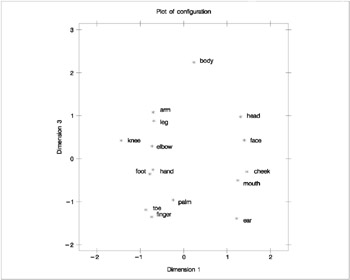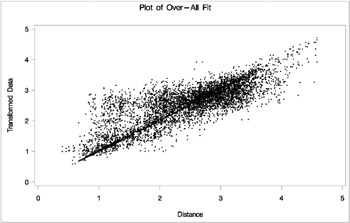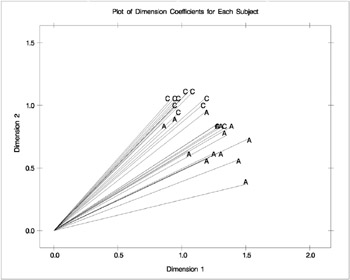Example
Example 43.1. Jacobowitz Body Parts Data from Children and Adults
Jacobowitz (1975) collected conditional rank-order data regarding perceived similarity of parts of the body from children of ages 6, 8, and 10 years and from college sophomores. The following analysis includes data from 15 children (6-year-olds) and 15 sophomores. The method of data collection and some results of an analysis are also described by Young (1987, pp. 4 ˆ’ 10). A portion of the data is included below. See Mds Documentation Examples in the SAS/STAT Sample Program Library for the complete data set.
data body; title 'Jacobowitz Body Parts Data from 6 Yr Olds and Adults'; title2 'First 15 subjects (obs 1-225) are children'; title3 'Second 15 subjects (obs 226-450) are adults'; input (cheek face mouth head ear body arm elbow hand palm finger leg knee foot toe) (2.); if _n_ <= 225 then subject='C'; else subject='A'; datalines; 0 2 1 3 410 5 9 6 7 811121314 2 012 113 3 81011 9 7 4 5 614 3 2 0 1 4 9 511 6 7 810131214 2 1 3 0 4 9 5 611 7 810121314 10 111 2 0 6 3 4 51213 7 814 9 1412 9 613 0 8 7 51011 1 4 2 3 1214111013 5 0 4 1 3 2 6 9 7 8 5 714 8 6 9 1 0 2 3 410111213 1311121014 9 3 4 0 1 2 6 5 7 8 8 6 7 9 4 5 310 1 0 212111314 14 513 6 912 3 4 1 2 0 7 81011 14121311 9 7 4 6 5 310 0 8 1 2 1211141013 4 5 8 6 7 9 1 0 2 3 1214101311 9 4 5 8 6 7 2 3 0 1 13 8 91114 3 6 5 71012 2 4 1 0 0 4 2 311 91412 1 713 8 6 510 7 011 9 1 2 8 3131410 612 4 5 1011 0 3 7 1 813 212 6 914 5 4 4 811 0 1 2 3 9 71310 51412 6 14 61110 0 1 2 4 9 8 5 713 312 11 61412 3 013 2 1 9 5 410 7 8 1412 8 3 1 7 013 2 6 5 911 410 610 914 3 412 0 813 5 711 1 2 131412 1 4 6 2 7 010 9 311 8 5 6 9 711 3 5 112 2 013 810 414 10 6 9 81113 712 2 1 014 5 3 4 6 9 710 4 21214 1 813 0 3 511 13 2 8 3 1 5 9141211 7 6 010 4 1411 8 413 212 9 5 310 6 7 0 1 14 3 4 713 6 2 8 91110 112 5 0 ... 405 lines omitted ... 0 1 2 4 3141210 6 5 81311 7 9 2 0 3 1 414 810 5 612 911 713 2 1 0 4 31412 9 511 71310 6 8 2 1 4 0 314 810 61112 7 9 513 1 3 2 4 01412 9 8 7 5131011 6 131011 114 0 3 7 512 8 2 6 4 9 13 911101214 0 1 3 6 5 2 4 7 8 1012 813 914 1 0 611 4 3 2 5 7 12 911101314 5 4 0 1 3 8 6 2 7 91211131014 5 4 1 0 2 6 7 3 8 10121113 914 6 5 1 3 0 8 7 4 2 121011 91314 2 5 6 8 7 0 1 3 4 1112 9131014 3 2 7 8 4 1 0 5 6 121011 91314 5 8 1 6 7 3 4 0 2 10121113 914 8 7 4 6 2 3 5 1 0 ;
The data are analyzed as row conditional (CONDITION=ROW) at the ordinal level of measurement (LEVEL=ORDINAL) using the weighted Euclidean model (COEF=DIAGONAL) in three dimensions (DIMENSION=3). The final estimates are displayed (PFINAL). The estimates (OUT=OUT) and fitted values (OUTRES=RES) are saved in output data sets. The following statements produce Output 43.1.1:
| |
Jacobowitz Body Parts Data from 6 Yr Olds and Adults First 15 subjects (obs 1-225) are children Second 15 subjects (obs 226-450) are adults Nonmetric Weighted MDS Multidimensional Scaling: Data=WORK.BODY.DATA Shape=SQUARE Condition=ROW Level=ORDINAL Coef=DIAGONAL Dimension=3 Formula=1 Fit=1 Mconverge=0.01 Gconverge=0.01 Maxiter=100 Over=2 Ridge=0.0001 Alternate=MATRIX Badness- Convergence Measures of-Fit Change in ---------------------- Iteration Type Criterion Criterion Monotone Gradient -------------------------------------------------------------------------- 0 Initial 0.4091 . . . 1 Monotone 0.2053 0.2038 0.3012 0.3190 2 Gau-New 0.1937 0.0116 . . 3 Monotone 0.1862 0.007533 0.0410 0.2314 4 Gau-New 0.1847 0.001496 . . 5 Monotone 0.1779 0.006754 0.0372 0.1516 6 Gau-New 0.1773 0.000654 . . 7 Monotone 0.1758 0.001488 0.0187 0.0975 8 Gau-New 0.1755 0.000253 . . 9 Monotone 0.1751 0.000478 0.0104 0.0767 10 Gau-New 0.1750 0.000113 . . 11 Monotone 0.1748 0.000199 0.006467 0.0582 12 Gau-New 0.1747 0.0000592 . 0.0384 13 Gau-New 0.1747 0.0000184 . 0.009952 Convergence criteria are satisfied. Configuration Dim1 Dim2 Dim3 ------------------------------------------- cheek 1.46 0.77 0.30 face 1.40 0.56 0.43 mouth 1.25 0.97 0.51 head 1.31 0.39 0.97 ear 1.23 0.03 1.39 body 0.24 0.18 2.24 arm -0.70 1.23 1.08 elbow -0.73 0.40 0.29 hand -0.71 1.50 0.26 palm -0.24 1.59 0.96 finger -0.74 0.57 1.35 leg -0.69 1.44 0.88 knee -1.44 0.64 0.42 foot -0.78 1.51 0.36 toe -0.87 1.20 1.19
| |
options ps=60; proc mds data=body condition=row level=ordinal coef=diagonal dimension=3 pfinal out=out outres=res ; subject subject; title5 Nonmetric Weighted MDS; run;
Jacobowitz Body Parts Data from 6 Yr Olds and Adults First 15 subjects (obs 1-225) are children Second 15 subjects (obs 226-450) are adults Nonmetric Weighted MDS Multidimensional Scaling: Data=WORK.BODY.DATA Shape=SQUARE Condition=ROW Level=ORDINAL Coef=DIAGONAL Dimension=3 Formula=1 Fit=1 Dimension Coefficients subject 1 2 3 --------------------------------------------- C 1.18 1.02 0.76 C 0.94 1.05 1.01 C 0.94 1.01 1.05 C 1.08 1.10 0.79 C 0.98 1.05 0.97 C 1.28 0.85 0.79 C 0.90 1.03 1.06 C 0.95 1.04 1.01 C 1.18 1.06 0.69 C 0.95 0.99 1.05 C 1.07 1.13 0.76 C 0.98 0.94 1.08 C 1.34 0.82 0.73 C 0.95 0.99 1.05 C 1.03 1.09 0.86 A 1.30 0.82 0.80 A 1.05 0.64 1.22 A 1.28 0.85 0.81 A 0.95 0.88 1.15 A 1.34 0.75 0.80 A 1.27 0.81 0.85 A 1.50 0.37 0.78 A 1.38 0.82 0.64 A 1.44 0.56 0.78 A 1.53 0.73 0.36 A 1.18 0.95 0.84 A 0.85 0.86 1.24 A 1.29 0.62 0.97 A 1.20 0.58 1.10 A 1.25 0.61 1.04
Jacobowitz Body Parts Data from 6 Yr Olds and Adults First 15 subjects (obs 1-225) are children Second 15 subjects (obs 226-450) are adults Nonmetric Weighted MDS Multidimensional Scaling: Data=WORK.BODY.DATA Shape=SQUARE Condition=ROW Level=ORDINAL Coef=DIAGONAL Dimension=3 Formula=1 Fit=1 Number of Badness-of- Uncorrected Nonmissing Fit Distance Distance subject Data Weight Criterion Correlation Correlation ------------------------------------------------------------------------------ C 210 0.03 0.16 0.85 0.99 C 210 0.03 0.25 0.51 0.97 C 210 0.03 0.23 0.58 0.97 C 210 0.03 0.16 0.85 0.99 C 210 0.03 0.21 0.69 0.98 C 210 0.03 0.15 0.89 0.99 C 210 0.03 0.26 0.40 0.96 C 210 0.03 0.25 0.47 0.97 C 210 0.03 0.13 0.91 0.99 C 210 0.03 0.24 0.55 0.97 C 210 0.03 0.15 0.87 0.99 C 210 0.03 0.23 0.59 0.97 C 210 0.03 0.15 0.90 0.99 C 210 0.03 0.21 0.69 0.98 C 210 0.03 0.19 0.75 0.98 A 210 0.03 0.12 0.94 0.99 A 210 0.03 0.17 0.84 0.98 A 210 0.03 0.12 0.93 0.99 A 210 0.03 0.21 0.68 0.98 A 210 0.03 0.14 0.91 0.99 A 210 0.03 0.16 0.87 0.99 A 210 0.03 0.09 0.98 1.00 A 210 0.03 0.11 0.95 0.99 A 210 0.03 0.11 0.96 0.99 A 210 0.03 0.13 0.95 0.99 A 210 0.03 0.13 0.90 0.99 A 210 0.03 0.21 0.72 0.98 A 210 0.03 0.12 0.93 0.99 A 210 0.03 0.10 0.95 0.99 A 210 0.03 0.11 0.94 0.99 - All - 6300 1.00 0.17 0.84 0.98
The OUTRES= data set is used to produce a plot showing the overall fit of the model, with the transformed data on the vertical axis and the distances from the model on the horizontal axis. If the model fits perfectly , all points lie on a diagonal line from lower left to upper right. The vertical departure of each point from this diagonal line represents the residual of the corresponding observation. The HAXIS and VAXIS options in the PLOT statement specify that the horizontal and vertical axes use the definitions AXIS2 and AXIS1, respectively. The identical ORDER= options in each of these AXIS statements make physical distances on each axis comparable.
The following statements produce Output 43.1.2:
title1 'Plot of Over-All Fit'; axis1 label=(angle=90 rotate=0) minor=none order=(0 to 5 by 1); axis2 minor=none order=(0 to 5 by 1); proc gplot data=res; plot fitdata*fitdist/vaxis=axis1 haxis=axis2 frame cframe=ligr; run;
The OUT= data set is used to plot the configuration and dimension coefficients using the % PLOTIT macro. Again it is necessary to use the VTOH= option to make the axes commensurable. The configuration is plotted by selecting observations having _TYPE_ = ˜CONFIG with a WHERE statement and by using the _NAME_ variable to identify each body part on the plot.
The dimension coefficients are plotted by selecting observations having _TYPE_ = ˜DIAGCOEF and by using the Subject variable to distinguish children from adults on the plot. The following statements produce Output 43.1.3:
title1 'Plot of configuration'; %plotit(data=out(where=(_type_=CONFIG)), datatype=mds, labelvar=_name_, vtoh=1.75); %plotit(data=out(where=(_type_='CONFIG')), datatype=mds, plotvars=dim3 dim1, labelvar=_name_, vtoh=1.75); run; title1 'Plot of Dimension Coefficients for Each Subject'; %plotit(data=out(where=(_type_='DIAGCOEF')), symtype=vector, symbols=",datatype=mds, place=0, labelvar=subject, vechead=, ls=100, plotopts=hzero vzero); %plotit(data=out(where=(_type_='DIAGCOEF')), plotvars=dim3 dim1, symtype=vector, symbols=", datatype=mds, place=0, labelvar=subject, ls=100, vechead=, plotopts=hzero vzero); run;

Figure 43.1.3: Plot of Configuration for Body Parts Data

The plots of dimension coefficients in Output 43.1.4 show that children differ from adults primarily in the emphasis given to dimension 2. Children give about the same weight (approximately 1) to each dimension. Adults are much more variable than children, but all have coefficients less than 1.0 for dimension 2, with an average of

about 0.7. Referring back to the configuration plot, you can see that adults consider arm parts to be more similar to leg parts than do children. Many adults also give a high weight to dimension 1, indicating that they consider head parts to be more dissimilar from arm and leg parts than do children. Dimension 3 shows considerable variability for both children and adults.

